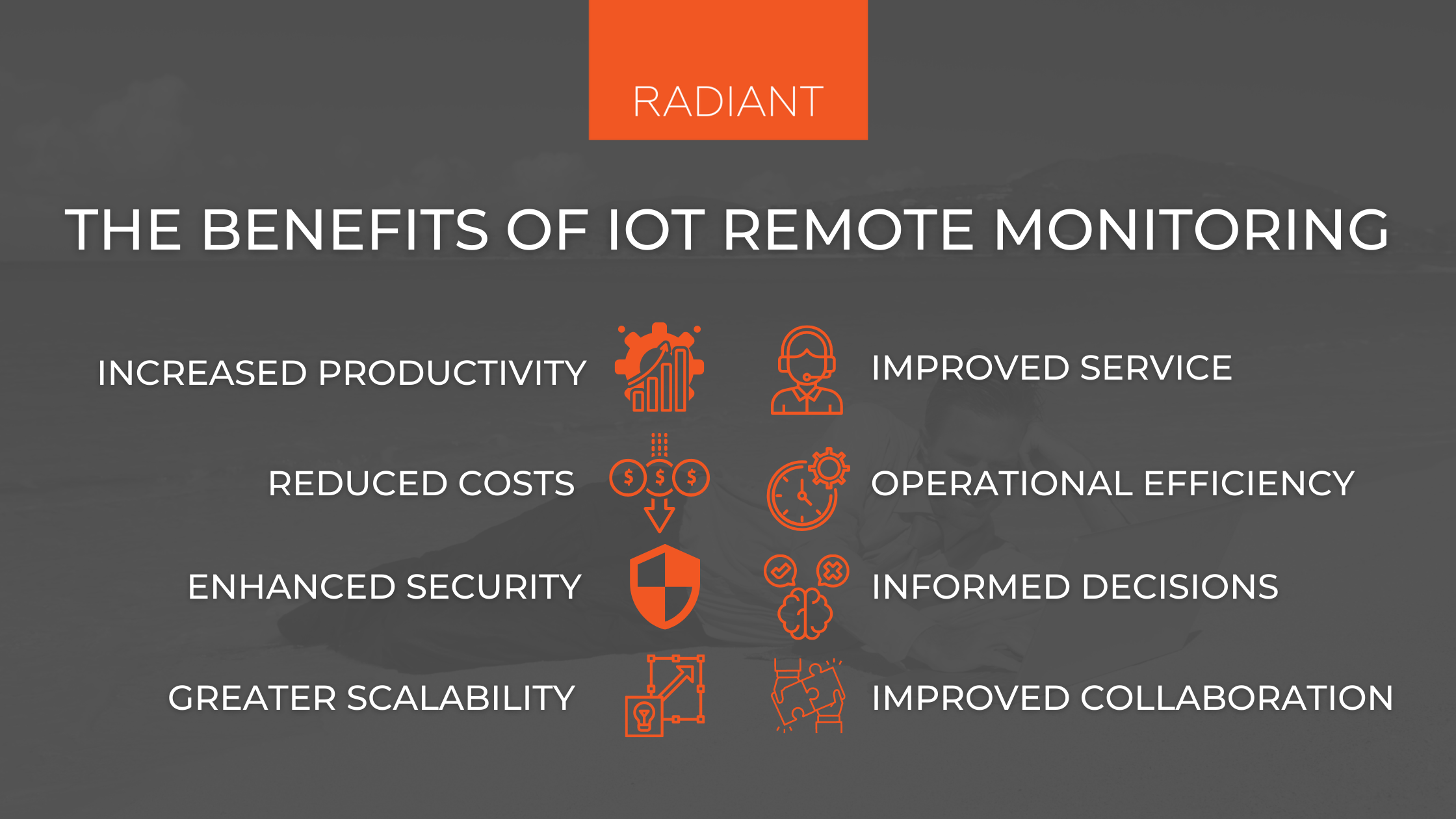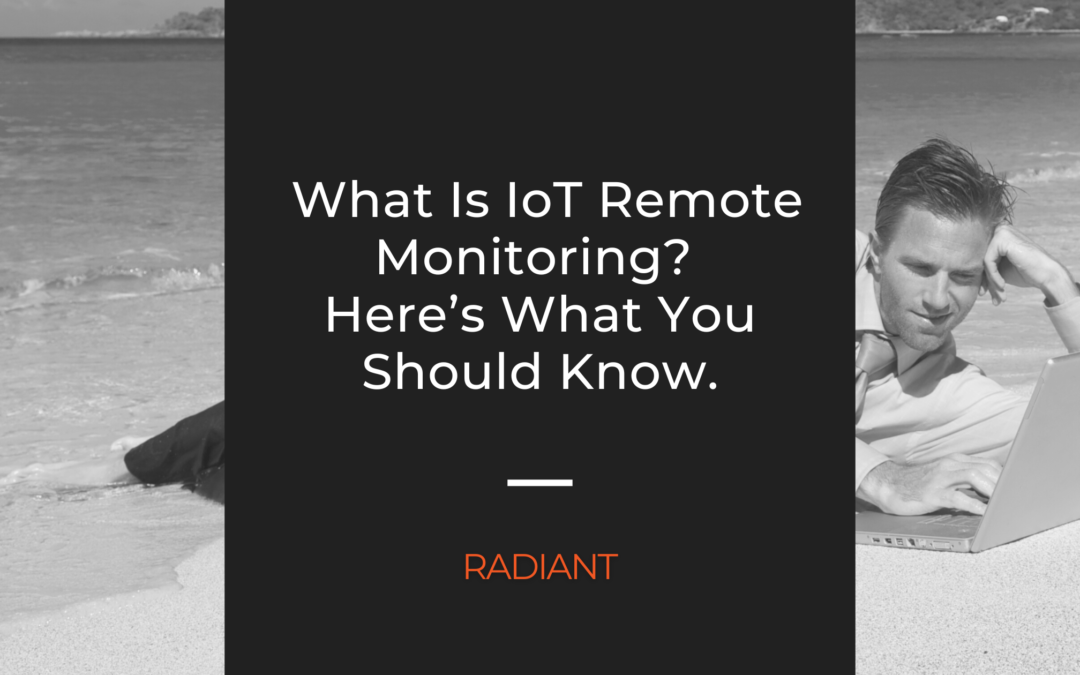When it comes to managing and tracking your assets, you want to make sure that you’re utilizing the most efficient strategies and technologies available.
That’s where IoT remote monitoring can come in and save the day – this powerful technology has been proven to streamline operations for businesses of all sizes.
In this blog post, we’ll provide a comprehensive overview of everything you need to know about IoT remote monitoring systems: from what exactly they are and how they work to why they’re invaluable for asset tracking purposes today. We’ll also discuss tangible benefits that companies gain by leveraging complex technological solutions like these; get ready to discover just how easy simplified asset management can be.
What Is IoT Remote Monitoring?
IoT remote monitoring is becoming an increasingly popular solution for businesses seeking to streamline their operations and improve efficiency.
Essentially, it involves the use of IoT devices and other hardware sensors with connectivity to the Internet to gather data on various aspects of a company’s operations, such as supply chain management, equipment maintenance, and environmental conditions. This data is then transmitted to a central system, where it can be analyzed and used to make informed decisions that improve performance and reduce costs.
With IoT remote monitoring software, businesses can quickly identify potential issues and address them before they become major problems, saving time and resources in the process. It is a smart and dynamic asset management approach that has the potential to revolutionize the way companies operate in a variety of industries.
How Does IoT Remote Monitoring Work?
IoT remote monitoring enables businesses to monitor everything from infrastructure and equipment performance to environmental conditions, inventory levels, and more.
The process of IoT remote monitoring involves several technologies, including IoT sensors, gateways, cloud platforms, and advanced analytics tools. The IoT sensors, such as BLE beacons and RFID tags, gather data from the equipment, which is then sent to the cloud platform via the gateway.
The data is then analyzed by advanced analytics tools to provide actionable insights and alerts for issues. This results in improved operational efficiency, reduced downtime, and cost savings for businesses.
This IoT-enabled technology is commonly used in industries such as manufacturing, transportation, and logistics, where it helps businesses optimize their supply chain and reduce costs. However, IoT remote monitoring is rapidly becoming an essential tool for businesses across industries, and its importance is only going to grow in the coming years.
Common Challenges In The Absence Of IoT Remote Monitoring
In today’s digital age, an IoT remote monitoring system has become an essential tool for businesses to stay connected and competitive. Without this sophisticated system in place, businesses may face a range of challenges that could hinder their growth and sustainability.
One of the most common issues is the lack of real-time data to make informed decisions, leading to delays in identifying and addressing problems.
Additionally, without an IoT remote monitoring system, businesses may struggle to maintain optimal asset performance, leading to productivity losses and increased downtime.
Another challenge is the risk of security breaches and cyber-attacks, which can compromise sensitive asset data and damage a brand’s reputation.
In short, the absence of an IoT remote monitoring system can have serious implications for businesses and their bottom lines, making it a critical investment for those looking to thrive in today’s fast-paced market.
To receive a monthly newsletter highlighting our newest and most popular blogs, sign-up below.
What Are The Benefits Of IoT Remote Monitoring For Businesses?

Increased Productivity: One of the primary benefits of using an IoT remote monitoring solution is that it can help to increase productivity. By monitoring connected devices and systems remotely, businesses can avoid the need for on-site personnel to constantly check on them. This can free up employees to focus on other tasks, leading to increased productivity.
Improved Customer Service: Another benefit of implementing an IoT remote monitoring system is that it can improve customer service. By monitoring customer-facing systems remotely, businesses can quickly identify and resolve any problems that may arise. This can lead to happier customers and improved customer retention rates.
Reduced Maintenance Costs: Additionally, using an IoT remote monitoring solution can help to reduce maintenance costs by enabling predictive maintenance. By monitoring devices and systems remotely, businesses can identify problems and perform cost-effective, proactive maintenance before they become expensive to fix. This can save businesses a significant amount of money over time.
Operational Efficiency: Another benefit of using an IoT monitoring solution is that it can help to increase operational efficiency. By using IoT sensors and smart devices to collect data and track performance in real-time, you can quickly identify and resolve any issues that may arise without having to wait for someone to physically inspect the equipment.
Additionally, remote monitoring can help you to optimize your processes and procedures to ensure that they are running as efficiently as possible to minimize energy consumption.
Enhanced Security: An IoT solution can also enhance security by enabling real-time monitoring. By monitoring devices and systems remotely in real-time, businesses can quickly identify and resolve any security issues that may arise. This can help to protect businesses from data breaches and other security threats.
Better Informed Decision Making: Businesses that have adopted an IoT remote monitoring solution have also found that it helps to improve decision-making. By collecting accurate data from devices and systems, businesses can gain insights into their operations that they would not otherwise have access to. This real-time data can be used to make better decisions about how to run the business, leading to improved profitability.
Greater Scalability: Another benefit of using an IoT remote monitoring solution is that it is highly scalable. As businesses grow, they can easily add new devices and sensors to their existing system without incurring significant additional costs. This scalability makes IoT remote monitoring solutions ideal for businesses of all sizes
Improved Collaboration: Lastly, an IoT remote monitoring solution also allows for improved collaboration between team members. By sharing real-time data and actionable insights remotely, team members can work together more effectively to resolve issues or make improvements.
Additionally, remote monitoring can help team members stay up-to-date on the latest information about your devices and systems, which can improve their ability to provide support when needed.
Key Considerations When Selecting An IoT Remote Monitoring Solution
As businesses increasingly rely on the Internet of Things (IoT) for remote monitoring, it’s essential to understand what key considerations to take if you think this technology is right for you.
Firstly, it’s important to assess your own needs and goals for an IoT remote monitoring system, ensuring that it would deliver real value to your business. Once this is established, you should select a platform that can integrate with your existing systems, minimizing disruption and reducing the risk of compatibility issues.
For the best results, businesses should also work with an experienced IoT solution provider, who can guide them through the process and customize a solution that meets their specific requirements.
These key considerations will help businesses make an informed decision about incorporating IoT remote monitoring into their operations, boosting efficiency, and empowering them to make data-driven decisions.
Ready To Get Started With IoT Remote Monitoring?
IoT remote monitoring has the potential to revolutionize enterprise operations and asset tracking, giving managers improved oversight and control over their business.
By automating tasks, remotely monitoring equipment and data, and ensuring compliance with regulations, businesses can reduce costs, identify risks quickly, and enhance customer satisfaction. With the right IoT remote monitoring solution in place, organizations can maximize their performance and drive sustained success.
As you look to start leveraging this IoT technology for your own business needs, it is important to be mindful of critical factors such as system scalability, security features, user experience design, and provider experience when selecting an IoT remote monitoring system.
If you’re interested in learning more about how IoT remote monitoring can streamline your operations and unlock new opportunities for growth and improvement, explore our IoT asset tracking solution and request your demo below.
Are you ready to learn more? Request a demo.
Last Updated on April 25, 2023 by Radiant

